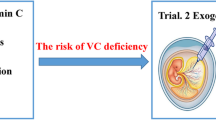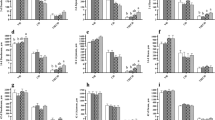Abstract
Xanthine oxidase (XO) is a member of xanthine oxidoreductase (XOR) enzyme system that catalyses the terminal reactions of purine degradation to uric acid (UA). The synthesis of both antioxidant (i.e. UA) and numerous free radicals makes XO an important regulator of the cellular redox potential involved in normal foetal development. The aim of this study was to investigate ontogenetic changes of enteric XO activity and UA content during the last week of chick embryonic development. Fertilized eggs (n = 180) of layer-breeder (Bovans White) and broiler-breeder hens (Ross 308) were incubated at 37.7 °C and 60 % relative humidity. Enteric XO activity (n = 10 for each strain) was spectrophotometrically measured, based on the generation of UA using xanthine as substrate, at various incubation days namely D14, D16, D18, D20 and D21. Intestinal XO activity and UA content of both strains fluctuated and showed polynomial relationships with embryo age. The XO activity tended to be increased from D14 and reached its maximum level around D18 in both strains; however, its activity returned to minimal values at D21. Intestinal XO activity in broiler embryos was higher when compared to that of layer embryos at D18. The pattern of change in levels of intestinal UA were similar for the two strains with the highest UA levels being detected at D21. We have shown that the intestinal XO activity and UA content of chick embryos fluctuates during the last week of embryonic development.


Similar content being viewed by others
References
Berry CE, Hare JM (2004) Xanthine oxidoreductase and cardiovascular disease: molecular mechanisms and pathophysiological implications. J Physiol 555:589–606
Bradford MM (1976) A rapid and sensitive method for the quantitation of microgram quantities of protein utilizing the principle of protein-dye binding. Anal Biochem 72:248–254
Buzála M, Janicki B, Czarnecki R (2015) Consequences of different growth rates in broiler breeder and layer hens on embryogenesis, metabolism and metabolic rate: a review. Poult Sci 94:728–733
Carro MD, Falkenstein E, Blemings KP, Klandorf H (2009) Determination of xanthine oxidoreductase activity in broilers: effect of pH and temperature of the assay and distribution in tissues. Poult Sci 88:2406–2414
Christensen VL, Wineland MJ, Fasenko GM, Donaldson WE (2001) Egg storage effects on plasma glucose and supply and demand tissue glycogen concentrations of broiler embryos. Poult Sci 80:1729–1735
Collin A, Berri C, Tesseraud S, Rodon FE, Skiba-cassy S, Crochet S et al (2007) Effects of thermal manipulation during early and late embryogenesis on thermotolerance and breast muscle characteristics in broiler chickens. Poult Sci 86:795–800
De Oliveira JE, Uni Z, Ferket PR (2008) Important metabolic pathways in poultry embryos prior to hatch. World’s Poult Sci J 64:488–499
Donaldson WE, Christensen VL (1991) Dietary carbohydrate level and glucose metabolism in turkey poults. Comp Biochem Physiol 98:347–350
Druyan S (2010) The effects of genetic line (broilers vs. layers) on embryo development. Poult Sci 89:1457–1467
Everaert N, Willemsen H, De Smit L, Witters A, De Baerdemaeker J, Decuypere E, Bruggeman V (2008) Comparison of a modern broiler and layer strain during embryonic development and the hatching process. Br Poult Sci 49:574–582
Fisher JR, Curtis JL, Woodward WD (1967) Developmental changes and control of xanthine dehydrogenases in developing chicks. Dev Biol 15(4):289–299
Gilbert ER, Li H, Emmerson DA, Webb KE Jr, Wong EA (2007) Developmental regulation of nutrient transporter and enzyme mRNA abundance in the small intestine of broilers. Poult Sci 86:1739–1753
Green DE (1934) Studies of reversible dehydrogenase systems: the reversibility of the xanthine oxidase system. Biochem J 28(4):1550–1560
Ho DH, Reed WL, Burggren WW (2011) Egg yolk environment differentially influences physiological and morphological development of broiler and layer chicken embryos. J Exp Biol 214:619–628
Hosomi A, Nakanishi T, Fujita T, Tamai I (2012) Extra-renal elimination of uric acid via intestinal efflux transporter BCRP/ABCG2. PLoS ONE 7(2), e30456. doi:10.1371/journal.pone.0030456
Janke O, Tzschentke B, Boerjan M (2004) Comparative investigations of heat production and body temperature in embryos of modern chicken breeds. Avian Poult Biol Rev 15:191–196
Kayyali US, Donaldson C, Hassoun PM (2001) Phosphorylation of XO/XD in hypoxia. J Biol Chem 276(17):14359–14365
Linder N, Martelin E, Lapatto R, Raivio KO (2003) Posttranslational inactivation of human xanthine oxidoreductase by oxygen under standard cell culture conditions. Am J Physiol Cell Physiol 285(1):48–55
Moran ET Jr (2007) Nutrition of the developing embryo and hatchling. Poult Sci 86:1043–1049
Morgan EJ (1930) Xanthine oxidase in the avian embryo. Biochem J 24(2):410–414
Settle T, Carro MD, Falkenstein E, Radke W, Klandorf H (2012) The effects of allopurinol, uric acid, and inosine administration on xanthine oxidoreductase activity and uric acid concentrations in broilers. Poult Sci 91:2895–2903
Stevens L (1996) Avian biochemistry and molecular biology. Cambridge University Press, Cambridge
Strittmatter CF (1965) Studies on avian xanthine dehydrogenases: properties and patterns of appearance during development. J Biol Chem 240(6):2557–2564
Sugawara N, Ohta T, Lai YR, Sugawara C, Yuasa M, Nakamura M, Tamura M (1999) Iron depletion prevents adenine nucleotide decomposition and an increase of xanthine oxidase activity in the liver of the Long Evans Cinnamon (LEC) rat, an animal model of Wilson’s disease. Life Sci 65:1423–1431
Terada LS, Piermattei D, Shibao GN, McManaman JL, Wright RM (1997) Hypoxia regulates xanthine dehydrogenase activity at pre- and posttranslational levels. Arch Biochem Biophys 348:163–168
Uni Z, Ferket PR, Tako E, Kedar O (2005) In ovo feeding improves energy status of late-term chicken embryos. Poult Sci 84:764–770
Uni Z, Tako E, Gal-Garber O, Sklan D (2003) Morphological, molecular, and functional changes in the chicken small intestine of the late-term embryo. Poult Sci 82:1747–1754
Vorbach C, Capecchi MR, Penninger JM (2006) Evolution of the mammary gland from the innate immune system? BioEssay 28:606–616
Vorbach C, Harrison R, Capecchi MR (2003) Xanthine oxidoreductase is central to the evolution and function of the innate immune system—a review. Trends Immunol 24(9):512–517
Acknowledgments
This paper emanates from Ph.D. thesis of second author, DN, in Avian Health and Diseases course submitted to the School of Veterinary Medicine, Shiraz University, Shiraz, Iran. This research was funded (grant No. 92-VE-736) by the Research Committee, School of Veterinary Medicine of Shiraz University, Shiraz, Iran.
Author information
Authors and Affiliations
Corresponding author
Ethics declarations
The protocol of this study has been reviewed and approved by the Animal Use Committee of Shiraz University that follows the recommendations stated in the Guide for the Care and Use of Laboratory Animals of the National Institutes of Health.
Conflict of interest
The authors declare that they have no conflict of interest.
Rights and permissions
About this article
Cite this article
Asasi, K., Naseri, D. & Karimi, I. Ontogenetic study of enteric xanthine oxidase in the chick embryos: focus on the late embryogenesis. Comp Clin Pathol 25, 625–629 (2016). https://doi.org/10.1007/s00580-016-2241-1
Received:
Accepted:
Published:
Issue Date:
DOI: https://doi.org/10.1007/s00580-016-2241-1




